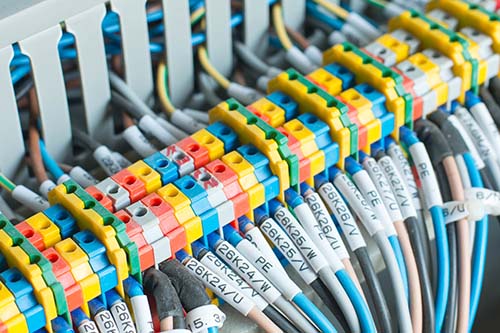What is structured wiring?
If you are a building owner or business manager, you may have heard about structured wiring or structured cabling and maybe even considered it for your office or facility. With structured cabling, multiple electronic devices, such as computers and telephones, are interconnected through a systemized infrastructure.
Why do you need it?
One of the top benefits of a structured wiring system is the eradication of messy wires. Replacing a multi-wire system with a controlled one makes the infrastructure easier to manage. Devices need to be plugged into the structured cable outlet rather than connected manually to a specific wire. This system is user-friendly and painless for your staff to adapt to. New and old devices are easily swapped with no frustration or hassle. Data can also be carried throughout these systems in all formats, so you can connect computers, printers, telephones and other devices easily.
Structured wiring contains a strategized combination of best practices that make up the design and construction of your business telecommunication organization.
- Efficiency – If your telecom communication needs expansion, sorting out a poorly organized wire system can be time consuming and frustrating. Organized wire systems are installed in a way that prevents tangles and upholds organization.
- Redundancy – Allowing for redundant operations within your cable system will allow for easy maintenance. If one cable is compromised, the system is set up in a way to allow communication to continue while repairs are made.
- Future usability – As technology continues to rapidly advance, it is very important to incorporate a system that is easily integrated and adaptable to future technology.
- Flexibility – Quick implementation of new additions, moves and changes is critical to your business productivity.
Structured Wiring for large companies
Organizations that have various branches situated at different countries and cities of the world, or companies with numerous departments with huge number of employees, require a proper and efficient networking system that connects to all their computers, faxes, printers, scanners etc. If the networking system is not properly installed it can create havoc in the organization. It becomes so much simpler with a well-organized system. Each company and every industry require a customized design that is most suitable for them specifically.
Customized service cable types
- Structured cabling
- Data cabling
- Network cabling
- Voice cabling
- CAT cable
- Cabe and fiber optics installation
- Network wiring
Easy Problem Diagnostics – In a multiple wiring system, it can be difficult to pinpoint the location of a problem. A structured wiring system is unified while also segmented, so problems are easily identified.
Flexibility with low costs – Keep up with common office changes like desk movement and office restructuring without the headache. Allow for easy transitions with easy plug in and plug out systems. Employees will even be able to plug in anywhere in the office and easily keep working.
Adaptability – Keep your business forward-thinking. Structured wiring systems are a great investment for the future. A system like this can carry large amounts of data at once with a very high bandwidth. Because of this, it takes a long time for this technology to become outdated. New equipment and applications that are important to your business growth are easily implemented throughout time.
Subsystems of Structured wiring
Structured wiring systems work because networks are organized into manageable subsystems. This type of organization ensures consistency, ensuring fewer flaws and inefficiencies overall.
- Entrance facilities – This is where the telephone or Internet access provider connects to the business network.
- Equipment rooms – Large networks have this environmentally controlled room that houses wiring equipment and consolidation points.
- Backbone cabling – These systems facilitate communications between the equipment rooms and entrance facilities.
- Horizontal cabling – This cabling connects telecommunications rooms to individual outlets and work areas on each floor.
- Telecommunications rooms – These connect between the backbone cabling and horizontal cabling.
- Work-area components – This hardware and cabling connect end-user equipment to outlets, dialing them into the network.
Important Planning Considerations for a Structured Wiring System
An effective, controlled cabling system supports all the communication needs of a company with the integrated flexibility that enables users to link to digital cameras, VoIP telephones, access control points, and data devices. Planning a security system upgrade will include several crucial considerations.
- Applications – What will the system accommodate as far as data, video, voice, and multimedia applications? What evolving technologies will be revised in the future?
- Service Period – Ideally, the service lifetime of a structured cabling system should be about 15 to 20 years as the backbone of an organization’s communications network.
- Compatibility – The applications that will function on the structured cabling system for the foreseeable future should be compatible with it.
- Bandwidth – As bandwidth demand will usually increase because of business growth, a company must consider future demand.
- Operators – For the 15 to 20-year service lifetime of the structured cabling system, the projected number of users during this period should determine the capacity needed.
- Alterations – Fiber-optic technologies are being developed rapidly, and the design of a structured cabling network should include flexibility in order to house modifications and additional users.
Structured cabling offers businesses a competitive advantage in a fast-paced society. If you are currently operating from two, independent phone and computer data cables, then you will rack up costs every time a new member of the team connects to the network. Structured cabling cuts out the middleman and allows you to plug in from anywhere in the system. Now, you can save money, increase communication speed and improve business efficiency all in one, simple solution.

